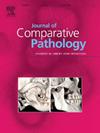Intestinal histoplasmosis with granulomatous colonic and mesenteric lymphadenitis due to Histoplasma mississippiense infection in an American Mammoth Jackstock donkey (Equus asinus)
IF 0.8
4区 农林科学
Q4 PATHOLOGY
引用次数: 0
Abstract
Histoplasmosis is a rarely reported clinical disease of equids in North America and is historically attributed to Histoplasma capsulatum var. capsulatum. This report details a case of intestinal histoplasmosis with lymphadenitis in an American Mammoth Jackstock donkey from Mississippi. Clinically, the donkey had chronic wasting, poor appetite, diarrhoea and an intra-abdominal mass detected by ultrasound. Grossly, the distal small and proximal large intestines contained multifocal, raised, tan, nodular, button ulcers along the mucosal surface. The associated colonic and mesenteric lymph nodes were severely enlarged, mottled tan to red and firm, and formed a large multinodular mass within the mesentery. Microscopically, lesions consisted of nodular infiltrates of epithelioid macrophages and multinucleated giant cells laden with numerous yeasts, along with mucosal ulceration and necrosis. Fungal polymerase chain reaction from lesioned intestines and lymph nodes targeting the internal transcribed spacer region yielded a 585 bp sequence that matched identically to two human isolates of Histoplasma mississippiense, one of several cryptic species previously classified together as H. capsulatum var. capsulatum endemic to North America. This case represents the first molecular identification of a Histoplasma species infecting a North American equid and the second report of histoplasmosis in a donkey from North America.
美洲长毛象长尾驴(马)的密西西比组织浆体感染引起的肠组织浆体病伴肉芽肿性结肠和肠系膜淋巴结炎。
组织浆菌病是一种在北美罕见的马科动物的临床疾病,历史上被认为是由荚膜组织浆体变异引起的。本报告详细介绍了一例肠道组织浆菌病伴淋巴结炎的病例,发生在一头来自密西西比州的美洲长毛象驴身上。临床表现为慢性消瘦,食欲不振,腹泻,超声检查发现腹腔内肿块。肉眼可见,小肠远端和大肠近端粘膜表面有多灶性、凸起、褐色、结节性、钮扣性溃疡。伴发结肠及肠系膜淋巴结严重肿大,黄褐色至红色,呈斑驳状,坚硬,并在肠系膜内形成大的多结节状肿块。镜下,病变包括结节样上皮样巨噬细胞浸润和携带大量酵母的多核巨细胞,并伴有粘膜溃疡和坏死。真菌聚合酶链反应从受损的肠道和淋巴结中靶向内部转录间隔区获得了585 bp的序列,与两个人类分离的密西西比组织浆菌完全匹配,密西西比组织浆菌是先前被归类为北美特有的荚膜孢子虫变体的几种隐种之一。本病例是对感染北美马科动物的组织浆体物种的首次分子鉴定,也是对感染北美驴的组织浆体病的第二份报告。
本文章由计算机程序翻译,如有差异,请以英文原文为准。
求助全文
约1分钟内获得全文
求助全文
来源期刊
CiteScore
1.60
自引率
0.00%
发文量
208
审稿时长
50 days
期刊介绍:
The Journal of Comparative Pathology is an International, English language, peer-reviewed journal which publishes full length articles, short papers and review articles of high scientific quality on all aspects of the pathology of the diseases of domesticated and other vertebrate animals.
Articles on human diseases are also included if they present features of special interest when viewed against the general background of vertebrate pathology.

 求助内容:
求助内容: 应助结果提醒方式:
应助结果提醒方式:


